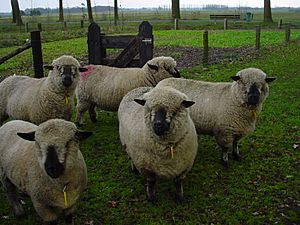Hampshire Down facts for kids
 |
|
| Other names | Hampshire Down |
|---|---|
| Country of origin | United Kingdom |
| Traits | |
| Weight |
|
| Wool color | White |
| Horn status | Both sexes are polled (hornless) |
|
|
The Hampshire Down, or simply Hampshire, is a type of sheep that comes from the United Kingdom. It was created around 1829. This breed was developed by mixing older sheep types like the Southdown, the Old Hampshire breed, the Wiltshire Horn, and the Berkshire Nott. These original sheep lived on the open, hilly lands of the Hampshire Downs. Today, the Hampshire is often used by farmers to breed lambs that grow quickly for meat.
Contents
How the Hampshire Sheep Was Developed
The Hampshire sheep was created by a farmer named John Twynam in Hampshire, England. Around 1829, he bred his local Hampshire sheep with Cotswold rams. The lambs from this cross-breeding were strong and well-built.
By 1835, these new sheep were being sold to start some of the first official Hampshire Down flocks in the United Kingdom. An important group of these sheep was kept at Downton Agricultural College in the late 1800s.
Changes Over Time
The original Southdown sheep had dark brown or black legs. They grew up fast and produced excellent meat, along with fine quality wool. The older Hampshire sheep were larger and tougher. They grew slower, had less desirable meat, and their wool was longer but not as fine.
The Southdown sheep were very good at passing on their traits to their offspring. Because of this, the new Hampshire Down sheep quickly took on many Southdown characteristics. For example, the horns that the original breeds had disappeared. The face and legs of the new sheep became dark. Their bodies became more compact, their bones smaller, and their backs broader. Their legs became shorter, and both their meat and wool improved in quality.
However, the new breed kept some good traits from the old Hampshire sheep. These included being very hardy and having a larger size. They also kept the large head and "Roman nose" (a nose with a slight bump) from the older breed. By the 1890s, Hampshire sheep grew quickly and were easy to fatten for market.
Wool and Meat Quality
Hampshire sheep in the 1890s produced about 6 to 7 pounds of wool. This wool was good for combing, meaning it could be used to make strong yarn. It was longer than Southdown wool but not as fine.
The meat from Hampshire sheep was very good. It had a nice balance of fat and lean parts, and it was juicy and flavorful. The lambs were usually born early in the season and raised to be sold for meat. You could think of the Hampshire as a larger, slightly tougher, and hardier version of the Southdown.
Sometimes, Hampshire sheep were bred with Cotswolds. This cross produced wool that was even better for making worsted fabrics than pure Cotswold wool. It's likely that the Hampshire breed has a little bit of Cotswold blood in its family tree.
Characteristics
Hampshire sheep are known for their size and strong build.
- Adult male sheep, called rams, should weigh 300 pounds (about 136 kg) or more when they are ready for breeding.
- Adult female sheep, called ewes, should weigh 200 pounds (about 91 kg) or more when they are ready for breeding.
Ewes typically produce between 6 to 10 pounds (2.7 to 4.5 kg) of wool. This wool has a thickness of 25.0 to 33.0 microns. A micron is a very small unit of measurement, used to describe how fine or coarse wool fibers are. The wool fibers are usually 2.0 to 3.5 inches (5 to 9 cm) long.
See also
 In Spanish: Hampshire (oveja) para niños
In Spanish: Hampshire (oveja) para niños

